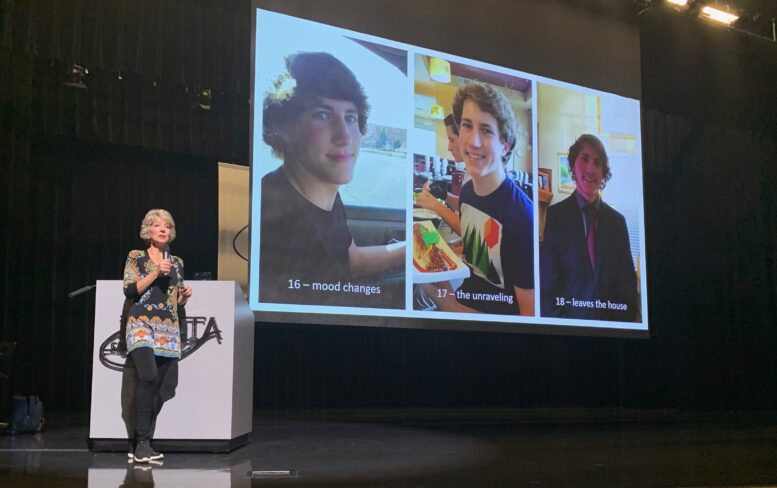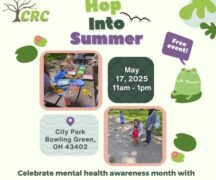By JULIE CARLE
BG Independent News
Days before 19-year-old Johnny Stack jumped from a six-story building to his death, he told his mother she was right all along. Early in his five-year addiction to high-potency marijuana, Laura Stack told her son not to use it “because that brilliant mind of yours would be destroyed.”
“Marijuana has ruined my mind and my life. I’m sorry, and I love you,” Stack remembered him saying three days before his Nov. 20, 2019, death.
(This article is about suicide. If you or someone you know needs support now, call or text 988 or chat 988lifeline.org.)
Relaying the nightmare their family lived through with his on-again, off-again and mostly on-again addiction to high-potency marijuana, was the story behind her warnings this week during several local presentations. Sponsored by the Wood County Addiction Task Force, Wood County Educational Service Center, Children’s Resource Center and Wood County Prevention Coalition, Stack spoke to high school students at Elmwood, Perrysburg and Rossford and to adults and parents at Penta Career Center.
Her message was loud and clear: Today’s marijuana is drastically more dangerous than the marijuana of previous generations, especially to teens and young adults.
Stack, who now runs a nonprofit called Johnny’s Ambassadors, tries not to lecture but instead shares facts to counter marijuana misinformation, such as, “It’s medicinal. It’s harmless. It helps cure cancer and anxiety.” The truth is, she said, “It’s exactly the opposite,” with young brains being the most susceptible to the dangers.
Her story is backed by scientific research that proves high-THC (tetrahydrocannabinol ) marijuana products can harm youth.
The American Psychiatric Association states as much:
“There is no current scientific evidence that cannabis is in any way beneficial for the treatment of any psychiatric disorder, not PTSD, anxiety, bipolar, depression, psychosis.
In contrast, current evidence supports, at minimum, a strong association with cannabis use with the onset of psychiatric disorders. Adolescents are particularly vulnerable to harm given the effects of cannabis on neurological development.”
Risks and realities of high-THC marijuana
“I knew so little,” Stack said, when they started down the treacherous path of Johnny’s addiction to high-THC marijuana.
The biggest take-away, and the message she fervently shares with youths, parents and caregivers, is that THC and developing brains are not a good combination. Human brains don’t fully develop for girls until about their mid-20s and for boys, late-20s to 30.
Only recently has research discovered that THC has a very different effect on teen brains than alcohol, nicotine and opioids. None of them are good, she said, but “the whole brain is altered when THC gets into the CB1 (cannabinoid) receptors.”
It affects the entire nervous system and immune system.
“We know THC reduces memory as much as six to eight IQ points, which is the difference between an A and a C,” Stack said.
When THC hits the cerebellum, coordination and reaction time are decreased. THC in the amygdala, the emotional processing center of the brain, causes suspicion, paranoia and panic.
A 2022 study found that of 3 million youths between 12 and 17 who used THC-marijuana, half became addicted and developed cannabis use disorder.
Studies of youths in Denmark identified an increased risk for developing schizophrenia and psychosis for youths, especially males, who have cannabis use disorder, even in those individuals without a predisposition to mental illnesses.
A Canadian study of 12 million people found that of the 14- to 18-year-olds who showed up in emergency rooms exhibiting cannabis-induced psychosis, in three years 41.3% were diagnosed with schizophrenia.

What else she learned during and after Johnny’s addiction to marijuana that she tells teens, parents, teachers and others to educate them of THC’s dangers:
- Cannabis is the umbrella term or the genus of flowering plants that include marijuana, the drug variety, and hemp, the non-drug variety.
- Hemp contains very little (less than 0.3%) THC, the psychoactive ingredient in marijuana that makes people high. Instead, hemp contains non-psychoactive cannabidiol, better known as CBD. “You could smoke hemp all day long and not get high,” she said.
- “Clever chemists” have learned how to alter CBD to become Delta 8-THC, “which is psychoactive,” Stack said. Delta 8 products show up in stores such as head shops and dollar stores, because it is a derivative of CBD, which became legal in all 50 states when the 2018 U.S. Farm Bill passed.
- The THC content of marijuana from Woodstock days was 1-2% in a gram of the flower. People started crossing various strains of marijuana to create stronger strains of the plant. Today, the average THC found in dispensaries’ plants averages 20% but can be found as high as about 40%.
- Because marijuana plants cannot hold more than about 40% THC, the industry found another way to increase the THC. The marijuana flower buds are put into chambers and a toxic solvent of butane, propane or ethanol is poured over the buds to extract the THC. The plant is tossed leaving no organic matter; the THC is made into solid and liquid concentrates to be turned into various products with THC of 60-99%.
- A dab refers to a small amount of the cannabis extract. A “serving size” is comparable to a period (.) in a 20-point Times New Roman font.
- Dabbing, a method for consuming a dab of cannabis involves using a hot surface to vaporize the dab and inhaling the vapor. “The 100% chemical vapor comes into your lungs, your blood and into your brains. You are high and it happens quickly,” Stack said.
- One dab is the equivalent of “50 joints back in the day.”
- Cannabis concentrates can be made into oils and vaped. They come in flavors, but youths tend not to use the flavors that can be smelled by their parents.
- Gummies pose a huge threat because each 50 mg gummy is actually five servings. “Are teens reading that? Of course not,” Stack said. “They aren’t just eating the ear off a gummy bear, they eat the whole thing,” and often more than one gummy because the effect takes longer.
Johnny’s life & death story
“Johnny was a sweet, intelligent, happy and handsome child,” Stack said. “He was funny, sensitive and creative.”
He started using marijuana at 14, two years after it was legalized and the same year it showed up in local dispensaries in Colorado where they lived.
Peer pressure at his first high school party got him started, even though the family had strict rules about no drinking, no smoking, no drugs.
“How did I know? He told us,” Stack said. When he told his mom and his dad, John, they were surprised because he had always been a good son and a rule follower.
She admitted at the time she thought, “What’s the big deal? It’s only pot, weed.” She remembered being with friends in high school in the 1980s, passing a joint around and asking each other if they were high. And she turned out OK.
“I was so wrong, so ignorant and so uneducated about what had happened to marijuana” over the years, she said.
At 16, he was using daily. He started to withdraw from sports, clubs and church youth groups, but he was still getting great grades in school.
“It didn’t look like anything was going on until it did,” she said. “It was very sudden. And it was very drastic.”
Right before his senior year in high school, “Everything changed, as if an alien came and took my child,” she said. “The one left with me was mean, toxic, verbally abusive, defiant and didn’t want to go to school, which was so unlike him.”
His grades slipped at the end of his senior year, but he still graduated with honors and was awarded a scholarship to attend Colorado State University. He was there for two weeks before he texted that he had been dabbing nonstop with his roommate and felt suicidal.
He was hospitalized and then released to go home, where he attempted suicide and was hospitalized again.
Once the THC was out of his body after four to six weeks, he was sober. “My son came back, the sweet, kind one,” she said. He moved back home so he could work and stay sober.
However, Johnny decided he wanted to go back to school. Despite his parents’ objections, he attended University of Northern Colorado. He was there two months before he was “back to the depths,” Stack said.
When she asked him why he started again after it almost killed him, he explained it was a built-in friend group. “Everyone who was using automatically accepts you,” he told her.
He called her from his dorm room one night at 3 a.m. certain that the university was an FBI base and “they” had bugged his room. When she tried to convince him that his thinking was not correct, he hung up on her. His parents went to pick him up and could not find him because he had been moved to a new room.
He left UNC, was put on antipsychotic medication to help with the delusions and went on to get a job and a puppy.
A month before his death, Johnny was doing fantastic, Stack said. They attended a Billy Joel concert—his favorite musician—after which he told her “Isn’t it awesome, Mom? This is the first day of the rest of my life. No more alcohol, cigarettes, marijuana.”
“Little did we know he also stopped talking his antipsychotic prescription. We don’t know and we will never know,” if he was using or if being off the medication restarted the delusions.
In the early hours of Nov. 21, she got a phone call that a deputy was at the front door and asked to come into the house. A woman from the coroner’s office explained that Johnny was dead from jumping off a parking garage.
“We don’t know if he meant to commit suicide or if he thought he could fly,” Stack said. “We do know Johnny is a statistic of many, many thousands of children who are dying by suicide. And even over alcohol, THC is the most common substance in their systems.”

Her book about his life, “The Dangerous Truth About Today’s Marijuana: Johnny Stack’s Life and Death Story,” was written because she was “desperately afraid I was going to forget his life.”
It is also the reason she and John started the nonprofit Johnny’s Ambassadors in Johnny’s memory and to educate parents, teens, and communities about the dangers of today’s potent THC products on adolescent brain development, psychosis, and suicide.
“Everything we make as a nonprofit goes back to the community,” she said. The organization provides free materials to schools and teachers.
An industry concerned with profit, not teens
“We believe with all our hearts, none of this would have happened if he hadn’t started using,” Stack said.
The legalization of marijuana and the cannabis industry are major contributors to tragedies like Johnny’s and so many others.
“Big Pot is after our teens,” she said.
The number one users in their home state of Colorado, which was the first state to legalize recreational marijuana, are 18-24 year olds.
“They have to addict them when they are 14 to 17. They don’t care about the teens. It’s about the profit,” Stack said. “It’s a multi-billion-dollar operation. Addict them young so they can put them into that pipeline.”
The industry knows it’s dangerous, she said. The risks associated with THC use—psychotic disorders, delusions, mental health issues and addiction—are listed on a piece of paper that is included with each sale, Stack said.
Link between cannabis use and suicidal thoughts, plans, attempts
In Colorado, 12 years after the legalization of marijuana, suicide is considered the number one cause of death for 15- to 18-year-olds. “It never used to be that way,” she said. ”And the number one substance found in the toxicology of those youth is THC, not opioids, fentanyl, hard drugs, alcohol or nicotine,” she said.
Research from Johns Hopkins in March 2024 found cannabis use was associated with an increased risk of thoughts of suicide, suicide plans and attempts.
Stack said the study found that the annual suicide rate in 100,000 youths from 12-25 (when the brain is still forming), was 9.76 suicides in states where medical and recreational marijuana are illegal. In states with legal medical marijuana, the rate was 12.78, and in states that also legalized recreational marijuana, the suicide rate was 16.68.
Colorado used to be in the top 10 states with graduating seniors across the country, she said. Now, 12 years later, the state is near the bottom at 42.
“It has decimated our state. For every dollar we collect in revenue, we spend $4.5,” Stack said. Colorado has seen increases in crashes, crimes, calls to the poison control center, and visits to emergency centers and behavioral health centers.
As of October 2024, 24 states, three U.S. territories, and Washington, D.C. have legalized recreational marijuana. In addition, 38 states, the District of Columbia, and four out of five U.S. territories have legalized medical marijuana.
What’s next for Ohio?
As of November 2023, Ohio became one of the newest states to legalize recreational marijuana. Stack can’t believe states continue to legalize marijuana. Many adults who voted in favor of legalization “thought they were getting the weed from their giggle-and-pass-around days,” she said. “Now, this is what our kids got. There is no limit.”
What lies ahead in Ohio based on new research and Stack’s accounts scares Aimee Coe, director of community programs at the Wood County Alcohol, Drug Addiction and Mental Health Services Board. For many years, her focus at the county agency has been on programs that address the opioid epidemic and suicide.
After seeing what has happened in Colorado, she is bracing for what’s to come.
Bringing Johnny’s story to Wood County was a deliberate effort by the sponsoring agencies to educate teens and the public about the dangers of high-potency marijuana. They will continue to provide convenient access to mental health, alcohol and other drug addiction treatment as well as education, prevention and support services in Wood County.





